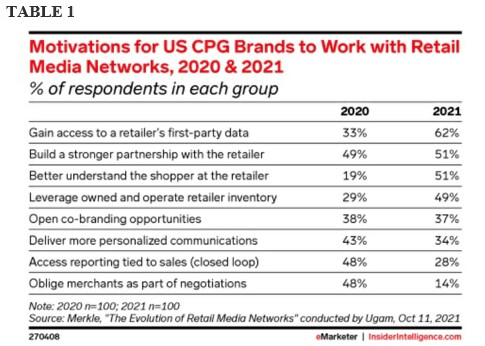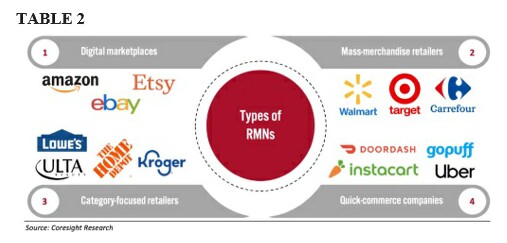Igniting Retail Media's Flywheel of Performance

Ancient Egyptians, Romans and Greeks were known to use retail signage for shop fronts, with promotional messaging strategically placed near their wares, amplified by town crier announcements to herald market days. Fast forward to the nineteenth century and Philadelphia retailer John Wanamaker once said: "Half the money I spend on advertising is wasted; the trouble is I don't know which half."
Today, Wanamaker most likely would have put Retail Media Networks in the "advertising that is not wasted" category, given its strong propensity to drive purchase in an immediate closed-loop marketing ecosystem, where viewing the ad can be directly correlated to customer action. Importantly, these networks also are dynamic brand building platforms reaching audiences before they are in transaction mode. Achieving both sales performance and brand-building has been an area of challenge that other digital advertising networks continue to struggle with.
Invite job candidates to apply live during the Media and Advertising Community’s Black Talent Outreach Week at MediaVillage.com and AdvancingDiversity.org October 17-20. Apply for jobs/submit your resume here.
What exactly are Retail Media Networks? They refer to a collection of digital channels owned by a retail company (web, app, in-store digital signage and in-store television) which is offered to third-party businesses for advertising purposes, enabling brands to advertise to prospects who are already in spending mode.
The Playing Field: Dynamic Forces Drive Growth
"Retail media is digital advertising's third big wave," Andrew Lipsman, principal analyst at Insider Intelligence, said in 2021. "Following the search ad market led by Google and the social ad market led by Facebook, this third wave led by Amazon is now cresting -- and ad budgets are ready to be unleashed with a fury."
With the acceleration of e-commerce in the face of a ravaging pandemic, more businesses rushed online in a bid to explore every available revenue-generating opportunity technology could offer, leading to the explosion of Retail Media Networks.
In 2022, U.S. digital retail media ad spending will reach $40.81 billion -- more than triple its pre-pandemic total and over 54% of the total global spending based on Insider Intelligence/eMarketer estimates. BCG estimates that the retail media market will grow by 25% per year to $100 billion over the next five years and will account for over 25% of total digital media spending by 2026.
With 74% of brands having dedicated budgets for retail media advertising, global retailers are eyeing the $75 billion 2022 high-margin prize, with retail giants Amazon and Walmart disclosing that their global retail advertising revenues in 2021 were $32.1 billion and $2.1 billion, respectively.
Adoption is increasing not only among these retail heavy weights, but also smaller-sized retailers who are recognizing the value of their first party data to drive sales and capture ad dollars from their brand customers. A summary of the top motivations for U.S. consumer packaged goods (CPG) brands to work with Retail Media Networks is in Table 1 (below), based on eMarketer research.

Retail margins have always been small, especially in the CPG sector, and there is continued pressure on pricing due to inflation and rising logistics costs. Retailers face intense competitive pressure from Amazon's low prices and free shipping and having an incremental revenue source enables them to compete on price and win customer loyalty.
Cartology, a leading Australian grocery Retail Media Network owned by Woolworths, is a great example of how to elevate customer loyalty as a competitive advantage. With over 13.5 million one-to-one relationships, they "hold a deep understanding of customer attitudes and behaviors and that's invaluable to brands," according to Stacey Lawson, head of campaign operations and delivery at the network. The business continues to innovate and partner to drive more delightful shopping experiences. "We can focus on creating the best in-store experience for Woolworths shoppers and drive sales overnight and customers over time for our valued clients," Lawson says.
The Players: In the Land of Giants, the Innovator Reigns
There are different categories of retailers (Table 2, below) capitalizing on the power of Retail Media Networks -- from mass merchandisers like Walmart and Target to digital marketplaces like Amazon and eBay to specialty category retailers like Lowes and Kroger to quick commerce/retail enablers like Instacart and DoorDash.

To protect their data, retailers have taken a walled garden approach with their emerging ad platforms. Today, the most innovative players are charting a different course than the traditional walled gardens approach of Google, Meta, Amazon and Snapchat. While retailers still erect protective walls around their customer data, they also rely on programmatic partners to pipe data and demand between their walled garden and the open ecosystem. For example, Walmart uses The Trade Desk as its DSP tech for Walmart's off-site ad sales, while Target's Roundel uses Index Exchange and Criteo supply-side tech. However, the major walled garden platforms, including the industry juggernaut Amazon, work minimally with open programmatic, if at all, according to AdExchanger.
The Promise: Purchase Trigger and Brand Builder
Often brands start with retail media as a sales driver, but that approach is going through a transformation as the brand-building power of retail media becomes increasingly evident. "Most brands are considering and approaching retail media as a performance and revenue driver, focusing on the lower funnel of the journey, but when they do that, they're missing so many opportunities," says Damien Lemaitre, Global Commerce Director at dentsu international. "They're just capturing the demand that already exists and not building demand to capture new customers. They're not building the brand."
With the overall operating margins of Retail Media Networks in the 50 to 70 percent range, companies across the retail spectrum are fully aware of the economic upside in a margin-pressured business. Amazon is a prime example of a company using its deep repository of e-commerce data to create an advertising business that extends beyond sponsored ads on its own shopping site. "We still see strong advertising growth," says Brian Olsavsky, CFO, Amazon. "If companies are looking to potentially streamline or optimize their advertising spend, we think our products compete very well in that regard, in addition to maybe longer-term things like brand building."
Despite the enthusiasm for Retail Media Networks, according to an Ad Age study only 21% of brands are happy with how their retail media dollars are currently allocated. This represents an opportunity to further engage across retailers, brands and agencies on how the medium can address both brand-building and performance marketing goals.
With the proliferation of greater digital channels, the lines are blurring between traditional media, digital and shopper marketing budgets. E-commerce, shopper and agency teams need to take into account that only 13.2% of all retail sales in the U.S. come from e-commerce websites. To scale, Retail Media Networks must reach the huge numbers of consumers who shop in brick-and-mortar stores, using mobile phone ads and digital displays inside of stores as well as on e-commerce sites.
The Potential: Data as Oil, Personalization as Engine
The COVID-19 pandemic was a major catalyst that not only raised the bar on consumer expectations but produced valuable signals on customer behavior that advertisers could learn from. The removal of cookies from web browsers is expected to be another major tailwind for retail media with first-party data being the oil that will drive the personalization engine to create a formidable competitive driver, enabling retailers and brands to claim a greater share of wallet and ensure enduring customer loyalty.
The valuable insights about why, how and where people shop will be the most critical currency as brands look to differentiate their offerings in categories that live in a sea of sameness. When CPG brands spend with a large retailer, they are immediately reaching customers just before or at the first moment of truth (in-store or digital aisle) and are able to successfully identify people with purchase intent, and as a media customer, the brand may also have potential access to better product placements within the store or on the retailer's e-commerce platform.
Importantly, first-party data comes into play to deliver on mass personalization at scale -- personalization that is based on individual customers, not simply customer personas. Walmart, as a top retail brand, relies on human connection to build their relationship with customers -- from 1:1 relationships in fixing luxury cars in their auto center to immediate and expert help from their pharmacists.
According to Jeff Clark, Officer and Vice President of Walmart's ad network Walmart Connect, some 230 million (global) customers a week visit its physical stores or site. "We're not just a grocery store, we're not just a pharmacy, we're not just an auto-care center," he noted. "We're all those things."
The Places You'll Go: Marching Towards Market Growth
The future of the Retail Media Networks sector is looking very bright. McKinsey predicts that commerce media has "the potential to generate over $1.3 trillion of enterprise value in the United States and create a paradigm shift in digital advertising not seen since the rise of programmatic."
Brands, retailers and agencies together can collaborate to share consumer insights, tweak creative and targeting tactics and inform data-driven marketing strategies. Customer-driven retailers and brands can share responsibility for the full customer experience and measure success with sales metrics, loyalty indicators and, importantly, in the measurement of customer lifetime value.
From the agency point of view, to ensure success leveraging Retail Media Networks, brands and retailers need to set shared goals and benchmarks, and then follow through with strategic testing to evaluate and refine offers and outcomes.
One exciting development will revolve around how the Metaverse and Web3 will impact Retail Media Networks. Today, Goldman Sachs cites this technology as an $8 trillion opportunity with unbridled enthusiasm among retailers on the potential business upside. Powered by a Metaverse platform, the networks could leverage a collective shared space and encompass both fully digital environments and digital enhancements to the physical world, with "multi-world" edge technologies including augmented reality/virtual reality (AR/VR), 5G, artificial intelligence (AI) and the cloud.
Retailers have to decide if they will use the Metaverse for selling or promotion or both. Today, the consumer-facing initiatives have focused on direct commerce, such as Nike selling branded NFTs or Forever21 opening a virtual storefront in the Metaverse. These initiatives will extend to immersive marketing, where Retail Media Networks could incorporate AR for hyper-personalized experiences.
Further, retailers globally face a multitude of options on how to drive sustainable performance, with Retail Media Networks increasingly becoming a core part of their growth and profitability strategy due to their closed-loop measurement, dynamic optimization and personalization capabilities. Retail Media Networks overcome the privacy and data issues plaguing the industry but need to elevate their performance through better shopper experiences, demonstrate impact on in-store purchases and across longer decision cycles, and prove return on ad spend as well as enhancement of customer lifetime value.
These enhancements will catapult Retail Media Networks to the top echelons of the media food chain -– a position that would make a modern-day Wanamaker say instead: "Half the money I spend on advertising is wasted; the good news is that retail media spend is part of the half that is not." That's a proclamation we will undoubtedly hear more on as brands, retailers and agencies follow the road to marketplace supremacy, capitalizing on a medium that beautifully brings together data, story, technology and immediacy to drive both sales performance and brand-building.
Watch the latest edition of Jack Myers Think Tank on the hidden $50 billion retail media business that's disrupting the purchase funnel.
Click the social buttons to share this story with colleagues and friends.
The opinions expressed here are the author's views and do not necessarily represent the views of MediaVillage.com/MyersBizNet.


